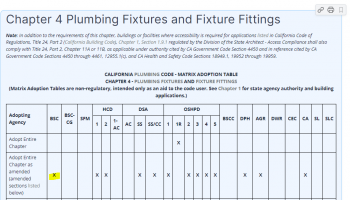nealderidder
Sawhorse
This has always been a mess and it seems like the latest code iteration (2022) isn't helping...
Let's start with CBC 2901.1: The last line says For minimum plumbing fixture requirements, see Table 422.1 of the California Plumbing Code.
This is immediately followed by 2902.1 Minimum number of fixtures and Table 2902.1 Minimum Number of Required Plumbing fixtures.
So do I use Table 422.1 of the CPC as directed or stay here and use Table 2902.1?
The CBC doesn't give any occupant load factors but says - The number of occupants shall be determined by this code.
I guess "this code" means the CBC but there are no occupant load factors given for determining plumbing fixtures. Do I use egress loads?
Now let's start with the CPC instead. CPC 422.1 tells me to figure the minimum number required with CPC Table 422.1 but only for OSHPD projects. It also mentions and Table 4-2 and Table 4-3 that maybe also only apply to OSHPD projects?
And then I get an "Exception" that says for BSC projects (private commercial, mostly what I do) I'm told to determine occupant load from CPC Table 4-1.
CPC Table 4-1 gives me load factors which are smaller (which equates to more fixtures) that the CPC Table A we used to use (which is now gone). Were we having a crisis of people waiting too long in line at an office building to use the bathroom? When's the last time you were in an office building and saw a crowd in the bathroom?
So say I figure my number of occupants using Table A - where next? Back to Table 422.1 that is maybe only for OSHPD? This table, by the way, tells me to determine occupant load with Table A (which was in the CPC but no longer exists). Or do I go back to the CBC and use Table 2902? These tables are not duplicates and don't provide the same result.
I feel like I'm being punked. Can anyone help me make sense of this?
Let's start with CBC 2901.1: The last line says For minimum plumbing fixture requirements, see Table 422.1 of the California Plumbing Code.
This is immediately followed by 2902.1 Minimum number of fixtures and Table 2902.1 Minimum Number of Required Plumbing fixtures.
So do I use Table 422.1 of the CPC as directed or stay here and use Table 2902.1?
The CBC doesn't give any occupant load factors but says - The number of occupants shall be determined by this code.
I guess "this code" means the CBC but there are no occupant load factors given for determining plumbing fixtures. Do I use egress loads?
Now let's start with the CPC instead. CPC 422.1 tells me to figure the minimum number required with CPC Table 422.1 but only for OSHPD projects. It also mentions and Table 4-2 and Table 4-3 that maybe also only apply to OSHPD projects?
And then I get an "Exception" that says for BSC projects (private commercial, mostly what I do) I'm told to determine occupant load from CPC Table 4-1.
CPC Table 4-1 gives me load factors which are smaller (which equates to more fixtures) that the CPC Table A we used to use (which is now gone). Were we having a crisis of people waiting too long in line at an office building to use the bathroom? When's the last time you were in an office building and saw a crowd in the bathroom?
So say I figure my number of occupants using Table A - where next? Back to Table 422.1 that is maybe only for OSHPD? This table, by the way, tells me to determine occupant load with Table A (which was in the CPC but no longer exists). Or do I go back to the CBC and use Table 2902? These tables are not duplicates and don't provide the same result.
I feel like I'm being punked. Can anyone help me make sense of this?





